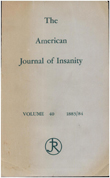High autonomic arousal and electrodermal orienting at age 15 years as protective factors against criminal behavior at age 29 years
Abstract
OBJECTIVE: Nothing is known about biological factors that protect a predisposed individual from becoming criminal. This 14-year prospective study tested the hypothesis that antisocial adolescents who desist from crime by age 29 have greater physiological arousal and orienting than antisocial adolescents who become adult criminals. METHOD: Physiological arousal and orienting were measured in 101 unselected 15- year-old male schoolchildren. Of these, 17 antisocial adolescents who desisted from adult crime (desistors) were matched on adolescent antisocial behavior and demographic variables with 17 antisocial adolescents who became criminal by age 29 (criminals), and 17 nonantisocial, noncriminal normal subjects. RESULTS: Desistors had significantly higher electrodermal and cardiovascular arousal and higher electrodermal orienting than the criminal group. CONCLUSIONS: This is the first study to report biological factors that protect against the development of criminal behavior. The findings suggest that individuals predisposed to adult crime by virtue of showing antisocial behavior in adolescence may be protected from committing crime by high levels of autonomic arousal and orienting.
Access content
To read the fulltext, please use one of the options below to sign in or purchase access.- Personal login
- Institutional Login
- Sign in via OpenAthens
- Register for access
-
Please login/register if you wish to pair your device and check access availability.
Not a subscriber?
PsychiatryOnline subscription options offer access to the DSM-5 library, books, journals, CME, and patient resources. This all-in-one virtual library provides psychiatrists and mental health professionals with key resources for diagnosis, treatment, research, and professional development.
Need more help? PsychiatryOnline Customer Service may be reached by emailing [email protected] or by calling 800-368-5777 (in the U.S.) or 703-907-7322 (outside the U.S.).



